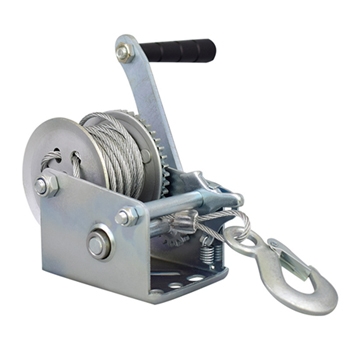When it comes to lifting and pulling heavy loads, the hand winch stands out as a reliable, cost-effective, and simple tool. While modern technology has introduced motorized winches that rely on electricity or fuel, the hand winch remains a timeless and indispensable tool for a wide variety of tasks. But what exactly is a hand winch, and why should you consider having one in your toolkit? In this blog, Tool.com will explore the mechanics, uses, and advantages of this practical piece of equipment.

What is a Hand Winch?
At its core, a hand winch is a manual mechanical device used to pull or lift heavy objects by winding a rope or cable around a drum or spool. Powered solely by human effort, the winch operates via a crank or handle that the user turns to rotate the drum. The mechanism allows you to lift or pull substantial weights with minimal effort, utilizing the principles of mechanical advantage to make seemingly difficult tasks manageable.
Though simple in design, hand winches are effective and efficient, allowing individuals to lift, haul, and move large objects that would otherwise be difficult to manipulate manually.
How Does a Hand Winch Work?
The operation of a hand winch is based on a basic yet powerful mechanism. The winch consists of a drum (or spool) around which a rope, cable, or chain is wound. As you turn the handle, the drum rotates, either pulling in or releasing the cable, depending on the direction of rotation. The cable, when wound tightly, exerts tension on the load, either lifting it up or pulling it across a surface.
Many hand winches are equipped with additional features such as ratcheting mechanisms or brakes. A ratchet mechanism prevents the load from rolling back after it has been lifted or pulled, providing greater control. Meanwhile, a brake system can help regulate the descent of a load, making it safer to lower heavy objects slowly and steadily.
Advantages of Using a Hand Winch
While there are various options available for lifting and pulling heavy loads, hand winches offer several advantages:
- Cost-Effective: One of the primary benefits of a hand winch is its affordability. Unlike electric or hydraulic winches that require motors, batteries, or fuel, hand winches are inexpensive to purchase and maintain. They are an excellent solution for those who need a reliable lifting or pulling device without the higher cost of powered alternatives.
- No Power Source Needed: Unlike electric winches that depend on a battery or generator, hand winches require no external power source. This makes them ideal for use in remote locations, off-grid scenarios, or in emergencies when electricity is unavailable. Whether you're stranded in the snow or on a remote job site, a hand winch can help you get the job done.
- Portability and Flexibility: Hand winches are portable and easy to transport, making them versatile for various applications. Whether you need to lift a car, load a boat, or move construction materials, hand winches can be used almost anywhere. Their compact design allows for easy storage, and their lightweight construction makes them easy to carry around.
- Low Maintenance: Another advantage of hand winches is their low maintenance requirements. These winches have fewer moving parts compared to motorized models, which reduces the chances of mechanical failure. With basic care and occasional lubrication, a hand winch can provide years of reliable service without the need for costly repairs.
- Reliability in Emergencies: In emergency situations where quick action is needed, a hand winch can prove invaluable. Whether you're trying to get a vehicle out of a muddy road or pull a load in an area where power sources are unavailable, a hand winch can be a lifesaver. Its simplicity and reliability make it a crucial tool in many emergency scenarios.
Applications of Hand Winches
Hand winches are incredibly versatile and are used in a wide range of applications, including:
- Boat Trailers: Lifting and towing boats onto trailers.
- Off-Roading: Recovering vehicles that are stuck in mud, snow, or sand.
- Construction and Heavy Lifting: Lifting or moving large equipment and materials.
- Personal Use: Moving large objects in a garage, warehouse, or backyard.
- Towing: Assisting with towing vehicles or machinery.
Things to Consider When Buying a Hand Winch
When purchasing a hand winch, focus on the following key factors:
- Load Capacity: Choose a winch with a capacity that exceeds the weight of the load you plan to lift. It's safer to have a bit of extra capacity than to risk overloading.
- Durability and Material: Opt for a winch made of durable, corrosion-resistant materials like galvanized steel or stainless steel, especially if you'll be using it outdoors.
- Gear Ratio: Consider the gear ratio, which affects how easily you can lift a load. A higher ratio makes lifting easier but slower, while a lower ratio offers more power but requires more effort.
By focusing on these essentials, you can select a hand winch that suits your needs and ensures reliable performance.
Conclusion
A hand winch is a reliable, versatile, and cost-effective tool for a wide range of lifting, pulling, and hauling tasks. Whether you need to rescue a vehicle from a tricky situation, load a boat onto a trailer, or lift heavy items in an industrial setting, a hand winch provides the mechanical advantage needed to make these tasks easier. With their simple operation, portability, and minimal maintenance requirements, hand winches are a great addition to anyone's toolkit. If you're looking for an affordable, reliable, and straightforward solution for lifting and pulling, a hand winch is the perfect tool to consider.

